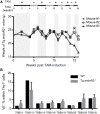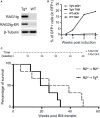iRAGu: A Novel Inducible and Reversible Mouse Model for Ubiquitous Recombinase Activity
- PMID: 29176980
- PMCID: PMC5686385
- DOI: 10.3389/fimmu.2017.01525
iRAGu: A Novel Inducible and Reversible Mouse Model for Ubiquitous Recombinase Activity
Abstract
Developing lymphocytes express the recombination activating genes (RAGs) 1 and 2 products that form a site specific recombinase complex (RAG), introducing double strand DNA breaks (DSBs) at recombination signal sequences (RSSs) flanking the V, D, and J gene segments in the antigen receptor loci. The subsequent steps in the reaction consist in the ligation of DSBs by ubiquitous enzymes of the non-homologous end joining DNA repair pathway. This mutagenesis process is responsible for the generation of the very large clonal diversity of T and B lymphocytes, itself allowing the recognition of a virtually open-ended antigenic universe. Sequences resembling RSS are found at high frequency all over the genome, and involved in RAG mediated illegitimate recombination and translocations. Hence, natural and induced ectopic activity of RAG is a threat to the genome only recently underscored. Here, we report and characterize a novel mouse transgenic system for which ubiquitous expression of the recombinase is inducible. In this system, the RAG1 protein is constitutively expressed and functional, while the RAG2 protein, coupled to the estrogen receptor, becomes functionally active upon 4-hydroxytamoxifen (TAM) administration. We describe two transgenic lines. The first one, when introgressed into an endogenous Rag2-/- genetic background is faithfully recapitulating lymphocyte development, repertoire dynamics and cryptic rearrangements, in a TAM-dependent manner. In this model, deprivation of TAM is followed by lymphocyte development arrest, evidencing the reversibility of the system. The second transgenic line is leaky, as the transgenes promote lymphocyte differentiation in absence of TAM treatment. Upon TAM-induction defects in lymphocytes composition and global health reveals the deleterious effect of uncontrolled RAG activity. Overall, this novel transgenic model provides a tool where RAG activity can be specifically manipulated to assess the dynamics of lymphocyte differentiation and the challenges imposed by the recombinase on the vertebrate genome.
Keywords: 4-hydroxytamoxifen induction; V(D)J recombination; estrogen receptor; lymphocyte development; recombination activating gene; transgenic mouse model.
Figures








Similar articles
-
Recombination signal sequences restrict chromosomal V(D)J recombination beyond the 12/23 rule.Nature. 2000 Jun 1;405(6786):583-6. doi: 10.1038/35014635. Nature. 2000. PMID: 10850719
-
The RAG recombinase: Beyond breaking.Mech Ageing Dev. 2017 Jul;165(Pt A):3-9. doi: 10.1016/j.mad.2016.11.003. Epub 2016 Nov 15. Mech Ageing Dev. 2017. PMID: 27863852 Review.
-
Germline DNA Retention in Murine and Human Rearranged T Cell Receptor Gene Coding Joints: Alternative Recombination Signal Sequences and V(D)J Recombinase Errors.Front Immunol. 2019 Nov 8;10:2637. doi: 10.3389/fimmu.2019.02637. eCollection 2019. Front Immunol. 2019. PMID: 31781122 Free PMC article.
-
Expression of recombination-activating genes and T cell receptor gene recombination in the human T cell leukemia cell line.Chin Med J (Engl). 2007 Mar 5;120(5):410-5. Chin Med J (Engl). 2007. PMID: 17376313
-
DNA bending in the synaptic complex in V(D)J recombination: turning an ancestral transpososome upside down.Discoveries (Craiova). 2014 Mar 29;2(1):e13. doi: 10.15190/d.2014.5. Discoveries (Craiova). 2014. PMID: 32309545 Free PMC article. Review.
Cited by
-
Co-evolution of mutagenic genome editors and vertebrate adaptive immunity.Curr Opin Immunol. 2020 Aug;65:32-41. doi: 10.1016/j.coi.2020.03.001. Epub 2020 Apr 27. Curr Opin Immunol. 2020. PMID: 32353821 Free PMC article. Review.
References
LinkOut - more resources
Full Text Sources
Other Literature Sources
Molecular Biology Databases

